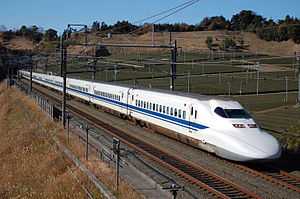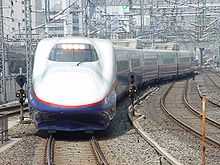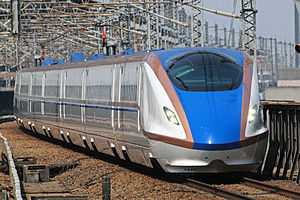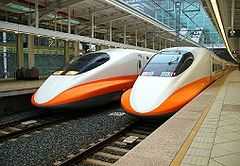N700 Series Shinkansen
| N700 series | |
|---|---|
|
JR Central N700 series set Z28 on the Sanyo Shinkansen, April 2009 | |
| In service | 2007–Present |
| Manufacturer | Hitachi, Kawasaki Heavy Industries, Kinki Sharyo, Nippon Sharyo |
| Replaced | 300 series, 500 series, 700 series |
| Constructed | 2005– |
| Number in service | 2,016 vehicles (141 sets) (as of 1 April 2014)[1] |
| Formation | 16 cars per trainset (8 cars per trainset for N700-7000/8000) |
| Capacity |
Tokaido/Sanyo 16-car sets (F, G, K, N, X, Z) 1,323 (200 Green + 1,123 Standard) Sanyo/Kyushu 8-car sets (R, S) 546 (24 Green + 522 Standard) |
| Operator | JR Central, JR Kyushu, JR West |
| Depot(s) | Tokyo, Hakata, Osaka, Kumamoto |
| Line(s) served | Kyushu Shinkansen, Tokaido Shinkansen, Sanyo Shinkansen, Hakata-Minami Line |
| Specifications | |
| Car body construction | Aluminium |
| Car length |
25,000 mm (82 ft 0 in) (intermediate cars) 27,350 mm (89 ft 9 in) (end cars) |
| Width | 3,360 mm (11 ft 0 in) |
| Height | 3,600 mm (11 ft 10 in), 3,500 mm (11 ft 6 in) (end cars) |
| Maximum speed |
270 km/h (168 mph) (Tokaido) 300 km/h (186 mph) (Sanyo) 260 km/h (162 mph) (Kyushu) |
| Weight | 715 t (16-car set)[2] |
| Traction system | 56 x 305 kW (409 hp) |
| Power output | 17.08 MW (22,900 hp) |
| Acceleration | 2.6 km/h/s |
| Electric system(s) | 25 kV AC, 60 Hz overhead catenary |
| Current collection method | Pantograph |
| UIC classification |
2'2'+14*Bo'Bo'+2'2' (N, Z and G sets) 8*Bo'Bo' (R and S sets) |
| Braking system(s) | Pneumatic, regenerative |
| Safety system(s) | ATC-1, ATC-NS, KS-ATC (R and S sets only) |
| Track gauge | 1,435 mm (4 ft 8 1⁄2 in) |
The N700 series (N700系) is a Japanese Shinkansen high-speed train with tilting capability developed jointly by JR Central and JR West for use on the Tokaido and Sanyo Shinkansen lines since 2007, and also operated by JR Kyushu on the Kyushu Shinkansen line.
N700 series trains have a maximum speed of 300 km/h (186 mph), and tilting of up to one degree allows the trains to maintain 270 km/h (168 mph) even on 2,500 m (8,200 ft) radius curves that previously had a maximum speed of 255 km/h (158 mph). Another feature of the N700 is that it accelerates quicker than other shinkansen trains, with a maximum acceleration rate of 2.6 km/h/s. This enables it to reach 270 km/h (170 mph) in only three minutes. Because of these improvements, trains can travel between Tokyo and Osaka on a Nozomi run in as little as 2 hours and 25 minutes (5 minutes faster than before).
Operations
N700 series trains gradually replaced 300, 500 and 700 series sets on Nozomi services, and by the end of February 2009, the N700 were responsible for 74 Nozomi services per day.[3] All Nozomi through runs (over the full route between Tokyo and Hakata) were scheduled to use the N700 exclusively by 2009. By 2011, all regularly scheduled Nozomi services, including runs limited only to the Tokaido Shinkansen, were operated by the N700.[4]
The N700 is also used on select Hikari services during the day, as well as some early-morning and late-night Kodama runs between Tokyo and Mishima/Hamamatsu.
Since March 2009, the N700 series trains have been equipped with wireless internet available for use between Tokyo and Shin-Osaka.[5]
Variants
- N700 series: 81 x 16-car "Z" sets owned by JR Central, introduced from 1 July 2007
- N700-1000 series "N700A": 16-car "G" sets owned by JR Central, introduced from 8 February 2013
- N700-2000 series "N700A": 16-car "X" sets owned by JR Central, modified from original "Z" sets from 2013
- N700-3000 series: 16 x 16-car "N" sets owned by JR West, introduced from 1 July 2007
- N700-4000 series "N700A": 16-car "F" sets owned by JR West, introduced from December 2013
- N700-5000 series "N700A": 16-car "K" sets owned by JR West, modified from original "N" sets from October 2013
- N700-7000 series: 19 x 8-car "S" sets owned by JR West, introduced from 12 March 2011
- N700-8000 series: 11 x 8-car "R" sets owned by JR Kyushu, introduced from 12 March 2011
16-car Z sets
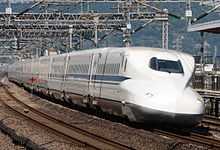
- 81 sets, Z0–Z80
The prototype 16-car train (Z0) was delivered in March 2005 for extensive testing and endurance running. Cars 1 to 4 were built by Hitachi Ltd., cars 5 to 14 were built by Nippon Sharyo, and cars 15 and 16 were built by Kawasaki Heavy Industries.[6]
The first full-production Z set (Z1) was delivered to JR Central in April 2007, and trains entered revenue service on 1 July 2007, with eight daily Nozomi service runs. The final Z set, Z80, was delivered from Kawasaki Heavy Industries in February 2012.[7]
From fiscal 2013, the fleet of Z sets is scheduled to undergo modifications to incorporate some of the improvements featured in the later N700A series sets. Modified sets are re-designated "X" sets, with cars renumbered in the -2000 subseries. The sets are also identified by the addition of a small "A" added to the right of the bodyside "N700" logos.[8]
The prototype set Z0 remains as a JR Central test train with cars numbered in the -9000 series, and is not used in revenue service.
-
"N700" logo
-

N700 series prototype set Z0 on a test run at Hamamatsu, January 2006
-

Set Z0, January 2011
Formation
The 16-car Z sets, Z0–Z80, are formed as follows.[1]
| Car No. | 1 | 2 | 3 | 4 | 5 | 6 | 7 | 8 | 9 | 10 | 11 | 12 | 13 | 14 | 15 | 16 |
|---|---|---|---|---|---|---|---|---|---|---|---|---|---|---|---|---|
| Designation | Tc | M2 | M'w | M1 | M1w | M' | M2k | M1s | M's | M2s | M'h | M1 | M1w | M' | M2w | T'c |
| Numbering | 783 | 787 | 786-500 | 785 | 785-300 | 786 | 787-400 | 775 | 776 | 777 | 786-700 | 785-600 | 785-500 | 786-200 | 787-500 | 784 |
| Seating capacity | 65 | 100 | 85 | 100 | 90 | 100 | 75 | 68 | 64 | 68 | 63 | 100 | 90 | 100 | 80 | 75 |
| Facilities | Toilets | Toilets / smoking room | Telephone | Toilets | Toilets / smoking room | Conductor's compartment / AED | Toilets / telephone | Smoking room | Toilets / multi-purpose compartment | Telephone | Toilets | Toilets / smoking room /telephone |
Cars 5 and 12 each have one single-arm pantograph.[1]
Interior
-
Z set standard-class car interior
-
Z set Green car (first class) seating
-

Interior of a smoking room
Fleet list
As at 1 April 2014:
| Set No. | Manufacturer | Date delivered[1] | Date converted to N700A[1] | Remarks |
|---|---|---|---|---|
| Z0 | Hitachi/Kawasaki HI/Nippon Sharyo | 12 March 2005 | Pre-series set | |
| Z1 | Nippon Sharyo | 17 April 2007 | Full-production sets | |
| Z2 | Hitachi | 9 May 2007 | ||
| Z3 | Nippon Sharyo | 21 May 2007 | ||
| Z4 | Hitachi | 16 June 2007 | ||
| Z5 | Nippon Sharyo | 23 June 2007 | ||
| Z6 | Hitachi | 5 September 2007 | 16 July 2013 | |
| Z7 | Nippon Sharyo | 12 September 2007 | 12 August 2013 | |
| Z8 | Hitachi | 31 October 2007 | 28 August 2013 | |
| Z9 | Nippon Sharyo | 22 October 2007 | 21 October 2013 | |
| Z10 | Hitachi | 6 December 2007 | 25 October 2013 | |
| Z11 | Nippon Sharyo | 29 November 2007 | 11 December 2013 | |
| Z12 | Kawasaki HI | 9 January 2008 | 21 January 2014 | |
| Z13 | Nippon Sharyo | 16 January 2008 | 31 January 2014 | |
| Z14 | Hitachi | 6 February 2008 | 27 February 2014 | |
| Z15 | Nippon Sharyo | 21 February 2008 | ||
| Z16 | Hitachi | 5 March 2008 | ||
| Z17 | Nippon Sharyo | 8 May 2008 | ||
| Z18 | Hitachi | 15 May 2008 | ||
| Z19 | Nippon Sharyo | 12 June 2008 | ||
| Z20 | Hitachi | 2 July 2008 | ||
| Z21 | Nippon Sharyo | 17 July 2008 | ||
| Z22 | Hitachi | 6 August 2008 | ||
| Z23 | Nippon Sharyo | 27 August 2008 | ||
| Z24 | Hitachi | 17 September 2008 | ||
| Z25 | Nippon Sharyo | 3 October 2008 | ||
| Z26 | Kawasaki HI | 16 November 2008 | ||
| Z27 | Nippon Sharyo | 9 November 2008 | ||
| Z28 | Hitachi | 21 December 2008 | ||
| Z29 | Nippon Sharyo | 14 December 2008 | ||
| Z30 | Kawasaki HI | 11 February 2009 | ||
| Z31 | Nippon Sharyo | 24 January 2009 | ||
| Z32 | Nippon Sharyo | 1 March 2009 | ||
| Z33 | Hitachi | 15 April 2009 | ||
| Z34 | Nippon Sharyo | 3 April 2009 | ||
| Z35 | Nippon Sharyo | 13 May 2009 | ||
| Z36 | Kawasaki HI | 26 August 2009 | 22 July 2013 | |
| Z37 | Nippon Sharyo | 18 June 2009 | ||
| Z38 | Nippon Sharyo | 24 July 2009 | 9 July 2013 | |
| Z39 | Nippon Sharyo | 3 September 2009 | 27 July 2013 | |
| Z40 | Hitachi | 8 July 2009 | 19 June 2013 | |
| Z41 | Nippon Sharyo | 11 October 2009 | 27 September 2013 | |
| Z42 | Nippon Sharyo | 14 November 2009 | 13 November 2013 | |
| Z43 | Hitachi | 1 December 2009 | 21 December 2013 | |
| Z44 | Nippon Sharyo | 17 December 2009 | 27 January 2014 | |
| Z45 | Hitachi | 13 January 2010 | 5 March 2014 | |
| Z46 | Nippon Sharyo | 27 January 2010 | 15 March 2014 | |
| Z47 | Hitachi | 17 February 2010 | 20 March 2014 | |
| Z48 | Nippon Sharyo | 1 March 2010 | ||
| Z49 | Nippon Sharyo | 2 April 2010 | ||
| Z50 | Nippon Sharyo | 9 May 2010 | ||
| Z51 | Nippon Sharyo | 9 June 2010 | ||
| Z52 | Nippon Sharyo | 10 July 2010 | ||
| Z53 | Hitachi | 21 July 2010 | ||
| Z54 | Nippon Sharyo | 18 August 2010 | ||
| Z55 | Nippon Sharyo | 18 September 2010 | ||
| Z56 | Hitachi | 1 October 2010 | ||
| Z57 | Nippon Sharyo | 21 October 2010 | ||
| Z58 | Hitachi | 10 November 2010 | ||
| Z59 | Nippon Sharyo | 21 November 2010 | ||
| Z60 | Nippon Sharyo | 22 December 2010 | ||
| Z61 | Hitachi | 19 January 2011 | ||
| Z62 | Nippon Sharyo | 28 January 2011 | ||
| Z63 | Hitachi | 23 February 2011 | ||
| Z64 | Nippon Sharyo | 3 March 2011 | ||
| Z65 | Nippon Sharyo | 6 April 2011 | 7 May 2013 | |
| Z66 | Hitachi | 20 April 2011 | ||
| Z67 | Nippon Sharyo | 13 May 2011 | ||
| Z68 | Nippon Sharyo | 15 June 2011 | 27 June 2013 | |
| Z69 | Nippon Sharyo | 16 July 2011 | 23 August 2013 | |
| Z70 | Hitachi | 3 August 2011 | 12 September 2013 | |
| Z71 | Nippon Sharyo | 20 August 2011 | 19 September 2013 | |
| Z72 | Hitachi | 7 September 2011 | 15 October 2013 | |
| Z73 | Nippon Sharyo | 22 September 2011 | 29 November 2013 | |
| Z74 | Nippon Sharyo | 24 October 2011 | 5 December 2013 | |
| Z75 | Hitachi | 3 November 2011 | 17 December 2013 | |
| Z76 | Nippon Sharyo | 23 November 2011 | 27 December 2013 | |
| Z77 | Nippon Sharyo | 22 December 2011 | 21 February 2014 | |
| Z78 | Nippon Sharyo | 29 January 2012 | 11 March 2014 | |
| Z79 | Hitachi | 22 February 2012 | ||
| Z80 | Nippon Sharyo | 1 March 2012 |
16-car G sets (N700-1000 series "N700A")
The N700-1000 series, or "N700A" (with "A" standing for "Advanced"), is a new version of the N700 series design delivered from August 2012, and entering revenue service from 8 February 2013.[1]
The new version is externally identical to the existing N700 series sets, with the addition of new "N700A" logos on each odd-numbered car.[9] The new trains include modified brake discs, bogie vibration detection, and ATC improvements.[10]
Six "G" sets were scheduled to be introduced during fiscal 2012, replacing older 700 series sets, with seven more sets introduced during fiscal 2013.[11] A further 18 sets are on order by JR Central, to be delivered six sets per year between fiscal 2014 and 2016 at a cost of 88 billion yen.[12]
The first set, G1, was delivered to Hamamatsu in August 2012, with test running commencing on the Tokaido Shinkansen the following month.[13]
-

Logo on the side of car 9, February 2013
Formation
The 16-car G sets are formed as follows, with car 1 at the Shin-Osaka (western) end and car 16 at the Tokyo (eastern) end.[1]
| Car No. | 1 | 2 | 3 | 4 | 5 | 6 | 7 | 8 | 9 | 10 | 11 | 12 | 13 | 14 | 15 | 16 |
|---|---|---|---|---|---|---|---|---|---|---|---|---|---|---|---|---|
| Designation | Tc | M2 | M'w | M1 | M1w | M' | M2k | M1s | M1sw | M2s | M'h | M1 | M1w | M' | M2w | T'c |
| Numbering | 783-1000 | 787-1000 | 786-1500 | 785-1000 | 785-1300 | 786-1000 | 787-1400 | 775-1000 | 776-1000 | 777-1000 | 786-1700 | 785-1600 | 785-1500 | 786-1200 | 787-1500 | 784-1000 |
| Seating capacity | 65 | 100 | 85 | 100 | 90 | 100 | 75 | 68 | 64 | 68 | 63 | 100 | 90 | 100 | 80 | 75 |
| Facilities | Toilets | Toilets / smoking room | Telephone | Toilets | Toilets / smoking room | Conductor's compartment / AED | Toilets / telephone | Smoking room | Toilets / multi-purpose compartment | Telephone | Toilets | Toilets / smoking room /telephone |
Cars 5 and 12 each have one single-arm pantograph.[1]
Interior
Internally, seats have new moquette seat covers, and LED lighting is used in toilets and washing areas.[11]
-
Green car seating (car 10), February 2012
Fleet list
As at 1 April 2014:
| Set No. | Manufacturer | Date delivered[1] | Remarks |
|---|---|---|---|
| G1 | Nippon Sharyo | 25 August 2012 | Fiscal 2012 batch |
| G2 | Hitachi | 7 November 2012 | |
| G3 | Nippon Sharyo | 16 November 2012 | |
| G4 | Nippon Sharyo | 22 January 2013 | |
| G5 | Hitachi | 30 January 2013 | |
| G6 | Nippon Sharyo | 22 February 2013 | |
| G7 | Hitachi | 17 April 2013 | Fiscal 2013 batch |
| G8 | Nippon Sharyo | 11 July 2013 | |
| G9 | Nippon Sharyo | 20 September 2013 | |
| G10 | Nippon Sharyo | 29 October 2013 | |
| G11 | Nippon Sharyo | 11 December 2013 | |
| G12 | Nippon Sharyo | 21 January 2014 | |
| G13 | Nippon Sharyo | 21 February 2014 | |
| G14 | Fiscal 2014 batch | ||
| G15 | |||
| G16 | |||
| G17 | |||
| G18 | |||
| G19 | |||
| G20 | Fiscal 2015 batch | ||
| G21 | |||
| G22 | |||
| G23 | |||
| G24 | |||
| G25 | |||
| G26 | Fiscal 2016 batch | ||
| G27 | |||
| G28 | |||
| G29 | |||
| G30 | |||
| G31 |
16-car X sets (N700-2000 series "700A")

These are former N700 series Z sets modified from fiscal 2013 onward to incorporate some of the design improvements featured in the later N700A series sets. Cars are renumbered in the -2000 subseries. The sets are also identified by the addition of a small "A" added to the right of the bodyside "N700" logos.[8]
All 80 Z sets in revenue service are scheduled to be modified to become X sets, with 32 sets modified during fiscal 2013, 37 sets to be modified during fiscal 2014, and the remaining 11 sets to be modified during fiscal 2015.[14]
Formation
The 16-car X sets are formed as follows.[1]
| Car No. | 1 | 2 | 3 | 4 | 5 | 6 | 7 | 8 | 9 | 10 | 11 | 12 | 13 | 14 | 15 | 16 |
|---|---|---|---|---|---|---|---|---|---|---|---|---|---|---|---|---|
| Designation | Tc | M2 | M'w | M1 | M1w | M' | M2k | M1s | M's | M2s | M'h | M1 | M1w | M' | M2w | T'c |
| Numbering | 783-2000 | 787-2000 | 786-2500 | 785-2000 | 785-2300 | 786-2000 | 787-2400 | 775-2000 | 776-2000 | 777-2000 | 786-2700 | 785-2600 | 785-2500 | 786-2200 | 787-2500 | 784-2000 |
| Seating capacity | 65 | 100 | 85 | 100 | 90 | 100 | 75 | 68 | 64 | 68 | 63 | 100 | 90 | 100 | 80 | 75 |
| Facilities | Toilets | Toilets / smoking room | Telephone | Toilets | Toilets / smoking room | Conductor's compartment / AED | Toilets / telephone | Smoking room | Toilets / multi-purpose compartment | Telephone | Toilets | Toilets / smoking room /telephone |
Cars 5 and 12 each have one single-arm pantograph.[1]
Fleet list
As at 1 April 2014:
| Set No. | Manufacturer | Date delivered[1] | Date converted to N700A[1] |
|---|---|---|---|
| X1 | Nippon Sharyo | 17 April 2007 | |
| X2 | Hitachi | 9 May 2007 | |
| X3 | Nippon Sharyo | 21 May 2007 | |
| X4 | Hitachi | 16 June 2007 | |
| X5 | Nippon Sharyo | 23 June 2007 | |
| X6 | Hitachi | 5 September 2007 | 16 July 2013 |
| X7 | Nippon Sharyo | 12 September 2007 | 12 August 2013 |
| X8 | Hitachi | 31 October 2007 | 28 August 2013 |
| X9 | Nippon Sharyo | 22 October 2007 | 21 October 2013 |
| X10 | Hitachi | 6 December 2007 | 25 October 2013 |
| X11 | Nippon Sharyo | 29 November 2007 | 11 December 2013 |
| X12 | Kawasaki HI | 9 January 2008 | 21 January 2014 |
| X13 | Nippon Sharyo | 16 January 2008 | 31 January 2014 |
| X14 | Hitachi | 6 February 2008 | 27 February 2014 |
| X15 | Nippon Sharyo | 21 February 2008 | |
| X16 | Hitachi | 5 March 2008 | |
| X17 | Nippon Sharyo | 8 May 2008 | |
| X18 | Hitachi | 15 May 2008 | |
| X19 | Nippon Sharyo | 12 June 2008 | |
| X20 | Hitachi | 2 July 2008 | |
| X21 | Nippon Sharyo | 17 July 2008 | |
| X22 | Hitachi | 6 August 2008 | |
| X23 | Nippon Sharyo | 27 August 2008 | |
| X24 | Hitachi | 17 September 2008 | |
| X25 | Nippon Sharyo | 3 October 2008 | |
| X26 | Kawasaki HI | 16 November 2008 | |
| X27 | Nippon Sharyo | 9 November 2008 | |
| X28 | Hitachi | 21 December 2008 | |
| X29 | Nippon Sharyo | 14 December 2008 | |
| X30 | Kawasaki HI | 11 February 2009 | |
| X31 | Nippon Sharyo | 24 January 2009 | |
| X32 | Nippon Sharyo | 1 March 2009 | |
| X33 | Hitachi | 15 April 2009 | |
| X34 | Nippon Sharyo | 3 April 2009 | |
| X35 | Nippon Sharyo | 13 May 2009 | |
| X36 | Kawasaki HI | 26 August 2009 | 22 July 2013 |
| X37 | Nippon Sharyo | 18 June 2009 | |
| X38 | Nippon Sharyo | 24 July 2009 | 9 July 2013 |
| X39 | Nippon Sharyo | 3 September 2009 | 27 July 2013 |
| X40 | Hitachi | 8 July 2009 | 19 June 2013 |
| X41 | Nippon Sharyo | 11 October 2009 | 27 September 2013 |
| X42 | Nippon Sharyo | 14 November 2009 | 13 November 2013 |
| X43 | Hitachi | 1 December 2009 | 21 December 2013 |
| X44 | Nippon Sharyo | 17 December 2009 | 27 January 2014 |
| X45 | Hitachi | 13 January 2010 | 5 March 2014 |
| X46 | Nippon Sharyo | 27 January 2010 | 15 March 2014 |
| X47 | Hitachi | 17 February 2010 | 20 March 2014 |
| X48 | Nippon Sharyo | 1 March 2010 | |
| X49 | Nippon Sharyo | 2 April 2010 | |
| X50 | Nippon Sharyo | 9 May 2010 | |
| X51 | Nippon Sharyo | 9 June 2010 | |
| X52 | Nippon Sharyo | 10 July 2010 | |
| X53 | Hitachi | 21 July 2010 | |
| X54 | Nippon Sharyo | 18 August 2010 | |
| X55 | Nippon Sharyo | 18 September 2010 | |
| X56 | Hitachi | 1 October 2010 | |
| X57 | Nippon Sharyo | 21 October 2010 | |
| X58 | Hitachi | 10 November 2010 | |
| X59 | Nippon Sharyo | 21 November 2010 | |
| X60 | Nippon Sharyo | 22 December 2010 | |
| X61 | Hitachi | 19 January 2011 | |
| X62 | Nippon Sharyo | 28 January 2011 | |
| X63 | Hitachi | 23 February 2011 | |
| X64 | Nippon Sharyo | 3 March 2011 | |
| X65 | Nippon Sharyo | 6 April 2011 | 7 May 2013 |
| X66 | Hitachi | 20 April 2011 | |
| X67 | Nippon Sharyo | 13 May 2011 | |
| X68 | Nippon Sharyo | 15 June 2011 | 27 June 2013 |
| X69 | Nippon Sharyo | 16 July 2011 | 23 August 2013 |
| X70 | Hitachi | 3 August 2011 | 12 September 2013 |
| X71 | Nippon Sharyo | 20 August 2011 | 19 September 2013 |
| X72 | Hitachi | 7 September 2011 | 15 October 2013 |
| X73 | Nippon Sharyo | 22 September 2011 | 29 November 2013 |
| X74 | Nippon Sharyo | 24 October 2011 | 5 December 2013 |
| X75 | Hitachi | 3 November 2011 | 17 December 2013 |
| X76 | Nippon Sharyo | 23 November 2011 | 27 December 2013 |
| X77 | Nippon Sharyo | 22 December 2011 | 21 February 2014 |
| X78 | Nippon Sharyo | 29 January 2012 | 11 March 2014 |
| X79 | Hitachi | 22 February 2012 | |
| X80 | Nippon Sharyo | 1 March 2012 |
16-car N sets (N700-3000 series)
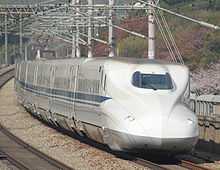
- 16 16-car sets, N1–N16
The 16-car N sets are operated by JR West on Tokaido and Sanyo Shinkansen services. The first set, N1, was delivered in June 2007, entering service on 1 July 2007.[1] 16 sets were in service as of April 2014.[1]
The fleet of 16 "N" sets are scheduled to undergo modifications at Hakata Depot between fiscal 2013 and fiscal 2015 to add improved braking systems and other features incorporated in the later N700A series sets.[14] Three sets will be treated during fiscal 2013, eight sets will be treated in fiscal 2014, and the remaining five sets will be treated in fiscal 2015.[14] Modified sets are re-designated "K" sets, with cars renumbered in the -5000 subseries.[14]
-

The logo on the side of car 13, May 2009
Formation
The 16-car N sets are formed as follows.[1]
| Car No. | 1 | 2 | 3 | 4 | 5 | 6 | 7 | 8 | 9 | 10 | 11 | 12 | 13 | 14 | 15 | 16 |
|---|---|---|---|---|---|---|---|---|---|---|---|---|---|---|---|---|
| Designation | Tc | M2 | M'w | M1 | M1w | M' | M2k | M1s | M's | M2s | M'h | M1 | M1w | M' | M2w | T'c |
| Numbering | 783-3000 | 787-3000 | 786-3500 | 785-3000 | 785-3300 | 786-3000 | 787-3400 | 775-3000 | 776-3000 | 777-3000 | 786-3700 | 785-3600 | 785-3500 | 786-3200 | 787-3500 | 784-3000 |
| Seating capacity | 65 | 100 | 85 | 100 | 90 | 100 | 75 | 68 | 64 | 68 | 63 | 100 | 90 | 100 | 80 | 75 |
| Facilities | Toilets | Toilets / smoking room | Telephone | Toilets | Toilets / smoking room | Conductor's compartment / AED | Toilets / telephone | Smoking room | Toilets / multi-purpose compartment | Telephone | Toilets | Toilets / smoking room /telephone |
Cars 5 and 12 each have one single-arm pantograph.[1]
Fleet list
As at 1 April 2014:
| Set No. | Manufacturer | Date delivered[1] | Date converted to N700A[1] |
|---|---|---|---|
| N1 | Kawasaki Heavy Industries | 1 June 2007 | |
| N2 | Kawasaki Heavy Industries | 10 July 2007 | |
| N3 | Nippon Sharyo | 6 August 2007 | |
| N4 | Nippon Sharyo | 9 October 2007 | 25 October 2013 |
| N5 | Kawasaki Heavy Industries | 10 November 2007 | 18 December 2013 |
| N6 | Kawasaki Heavy Industries | 13 September 2007 | |
| N7 | Kawasaki Heavy Industries | 12 September 2007 | |
| N8 | Kinki Sharyo | 31 January 2008 | |
| N9 | Kawasaki Heavy Industries | 20 May 2008 | |
| N10 | Kawasaki Heavy Industries | 17 November 2009 | |
| N11 | Kawasaki Heavy Industries | 18 December 2009 | |
| N12 | Kinki Sharyo | 28 January 2010 | |
| N13 | Kawasaki Heavy Industries | 15 October 2009 | 12 March 2014 |
| N14 | Kawasaki Heavy Industries | 28 February 2010 | |
| N15 | Hitachi | 23 May 2010 | |
| N16 | Hitachi | 14 December 2010 |
16-car F sets (N700-4000 series "N700A")
These are N700A series sets owned by JR West and classified N700-4000 series, with one set delivered in November 2013 and entering revenue service from 8 February 2014.[1] A further four sets are scheduled to be delivered in fiscal 2015, followed by four more in fiscal 2016.[15]
Fleet list
As of 1 April 2014, the fleet consists of one set, based at Hakata Shinkansen Depot.[1]
| Set No. | Manufacturer | Date delivered |
|---|---|---|
| F1 | Hitachi | 27 November 2013 |
16-car K sets (N700-5000 series "700A")
These are JR West trainsets modified from October 2013 from former N700 series N sets to incorporate some of the design improvements featured in the later N700A series sets.[14]
All 16 of the original N sets are scheduled to be modified, with three sets treated during fiscal 2013, eight sets in fiscal 2014, and the remaining five sets in fiscal 2015.[14]
Formation
The 16-car K sets are formed as follows.[1]
| Car No. | 1 | 2 | 3 | 4 | 5 | 6 | 7 | 8 | 9 | 10 | 11 | 12 | 13 | 14 | 15 | 16 |
|---|---|---|---|---|---|---|---|---|---|---|---|---|---|---|---|---|
| Designation | Tc | M2 | M'w | M1 | M1w | M' | M2k | M1s | M's | M2s | M'h | M1 | M1w | M' | M2w | T'c |
| Numbering | 783-5000 | 787-5000 | 786-5500 | 785-5000 | 785-5300 | 786-5000 | 787-5400 | 775-5000 | 776-5000 | 777-5000 | 786-5700 | 785-5600 | 785-5500 | 786-5200 | 787-5500 | 784-5000 |
| Seating capacity | 65 | 100 | 85 | 100 | 90 | 100 | 75 | 68 | 64 | 68 | 63 | 100 | 90 | 100 | 80 | 75 |
| Facilities | Toilets | Toilets / smoking room | Telephone | Toilets | Toilets / smoking room | Conductor's compartment / AED | Toilets / telephone | Smoking room | Toilets / multi-purpose compartment | Telephone | Toilets | Toilets / smoking room /telephone |
Cars 5 and 12 each have one single-arm pantograph.[1]
Fleet list
As at 1 April 2014:
| Set No. | Manufacturer | Date delivered[1] | Date converted to N700A[1] |
|---|---|---|---|
| K1 | Kawasaki Heavy Industries | 1 June 2007 | |
| K2 | Kawasaki Heavy Industries | 10 July 2007 | |
| K3 | Nippon Sharyo | 6 August 2007 | |
| K4 | Nippon Sharyo | 9 October 2007 | 25 October 2013 |
| K5 | Kawasaki Heavy Industries | 10 November 2007 | 18 December 2013 |
| K6 | Kawasaki Heavy Industries | 13 September 2007 | |
| K7 | Kawasaki Heavy Industries | 12 September 2007 | |
| K8 | Kinki Sharyo | 31 January 2008 | |
| K9 | Kawasaki Heavy Industries | 20 May 2008 | |
| K10 | Kawasaki Heavy Industries | 17 November 2009 | |
| K11 | Kawasaki Heavy Industries | 18 December 2009 | |
| K12 | Kinki Sharyo | 28 January 2010 | |
| K13 | Kawasaki Heavy Industries | 15 October 2009 | 12 March 2014 |
| K14 | Kawasaki Heavy Industries | 28 February 2010 | |
| K15 | Hitachi | 23 May 2010 | |
| K16 | Hitachi | 14 December 2010 |
8-car S sets (N700-7000 series)
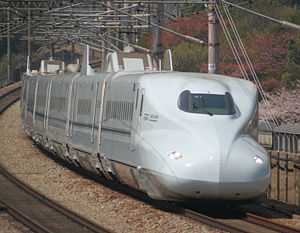
- 19 8-car sets, S1–S19
The N700-7000 series variant are 8-car sets operated by JR West on through-running Sakura and Mizuho services between Shin-Osaka and Kagoshima-Chūō on the Kyushu Shinkansen since 12 March 2011.[16] The pre-series set (S1) was delivered to Hakata Depot in October 2008. These trains do not feature the tilting mechanism of the earlier N700 trains, as they do not run on the Tokaido Shinkansen.[17]
External livery is shiraai (白藍?)
pale blue intended to evoke the colour of traditional porcelain with indigo and gold bodyside lining.[16]
Full-production JR West sets were delivered to Hakata Depot from early April 2010.[18] The final S set, S19, was delivered to Hakata Depot in February 2012.[7]
Formation
The 8-car S sets, S1–S19, are formed as follows.[1]
| Car No. | 1 | 2 | 3 | 4 | 5 | 6 | 7 | 8 |
|---|---|---|---|---|---|---|---|---|
| Designation | Mc | M1 | M' | M2 | M2w | M's | M1h | M'c |
| Numbering | 781-7000 | 788-7000 | 786-7000 | 787-7000 | 787-7500 | 766-7000 | 788-7700 | 782-7000 |
| Seating capacity | 60 | 100 | 80 | 80 | 72 | 36+24 | 38 | 56 |
Cars 2 and 7 each have one single-arm pantograph.[1]
-

781-7000 (Car 1)
-

788-7000 (Car 2)
-

786-7000 (Car 3)
-

787-7000 (Car 4)
-

787-7500 (Car 5)
-

766-7000 (Car 6)
-

788-7700 (Car 7)
-

782-7000 (Car 8)
Interior
These sets feature a Green car saloon in half of one car (car 6) consisting of 24 seats (6 rows) arranged in 2+2 abreast configuration with 480 mm (19 in) wide seats and a seat pitch of 1,160 mm (46 in). Cars 4 to 8 (including half of car 6) are designated as "reserved seating" cars with 2+2 abreast configuration, 465 mm wide seats and a seat pitch of 1,040 mm. Cars 1 to 3 are "non-reserved seating" cars with 2+3 abreast configuration, 440 mm wide seats (460 mm in middle of 3-seat row) and a seat pitch of 1,040 mm.[16]
-

N700-7000 series standard-class non-reserved car seating, April 2011
-

N700-7000 series standard-class reserved car seating, August 2011
-

A smoking room
Fleet list
As of 1 April 2014, the fleet consists of 19 sets, all based at Hakata Shinkansen Depot.[1]
| Set No. | Manufacturer | Date delivered |
|---|---|---|
| S1 | Kawasaki/Kinki Sharyo/Nippon Sharyo | 24 October 2008 |
| S2 | Kawasaki Heavy Industries | 20 April 2010 |
| S3 | Nippon Sharyo | 12 July 2010 |
| S4 | Kawasaki Heavy Industries | 22 June 2010 |
| S5 | Kawasaki Heavy Industries | 4 August 2010 |
| S6 | Kawasaki Heavy Industries | 14 September 2010 |
| S7 | Kinki Sharyo | 17 November 2010 |
| S8 | Kinki Sharyo | 14 January 2011 |
| S9 | Nippon Sharyo | 16 February 2011 |
| S10 | Nippon Sharyo | 12 April 2011 |
| S11 | Kawasaki Heavy Industries | 30 May 2011 |
| S12 | Kawasaki Heavy Industries | 24 June 2011 |
| S13 | Kawasaki Heavy Industries | 11 July 2011 |
| S14 | Kawasaki Heavy Industries | 1 August 2011 |
| S15 | Kawasaki Heavy Industries | 3 October 2011 |
| S16 | Kawasaki Heavy Industries | 23 October 2011 |
| S17 | Nippon Sharyo | 15 November 2011 |
| S18 | Kawasaki Heavy Industries | 23 January 2012 |
| S19 | Hitachi | 27 February 2012 |
8-car R sets (N700-8000 series)
- 11 8-car sets, R1–R10
The N700-8000 series variant consists of ten 8-car sets operated by JR Kyushu alongside JR West N700-7000 series "S" sets on through-running Sakura and Mizuho services between Shin-Osaka and Kagoshima-Chūō on the Kyushu Shinkansen since 12 March 2011.[1]
External livery is identical to the N700-7000 series "S" sets.
The first set, R1, was delivered to Kumamoto Depot in July 2010.[19] Test running on the unopened section of the Kyushu Shinkansen began on 31 August 2010.[20]
Formation
The 8-car R sets are formed as follows.[1]
| Car No. | 1 | 2 | 3 | 4 | 5 | 6 | 7 | 8 |
|---|---|---|---|---|---|---|---|---|
| Designation | Mc | M1 | M' | M2 | M2w | M's | M1h | M'c |
| Numbering | 781-8000 | 788-8000 | 786-8000 | 787-8000 | 787-8500 | 766-8000 | 788-8700 | 782-8000 |
| Seating capacity | 60 | 100 | 80 | 80 | 72 | 36+24 | 38 | 56 |
Cars 2 and 7 each have one single-arm pantograph.[1]
Interior
As with the JR West N700-7000 series sets, the R sets feature a Green car saloon in half of one car (car 6) consisting of 24 seats (6 rows) arranged in 2+2 abreast configuration. Cars 4 to 8 (including half of car 6) are designated as "reserved seating" cars with 2+2 abreast configuration. Cars 1 to 3 are "non-reserved seating" cars with 2+3 abreast configuration.[21]
-

Green class seating saloon, September 2011
-

Reserved car with 2+2 abreast seating, September 2011
-
Interior of a smoking room
Fleet list
As of 1 April 2014, the fleet consists of 11 sets, all based at Kumamoto Shinkansen Depot.[1]
| Set No. | Manufacturer | Date delivered |
|---|---|---|
| R1 | Hitachi | 11 December 2010 |
| R2 | Hitachi | 23 November 2010 |
| R3 | Hitachi | 6 December 2010 |
| R4 | Kawasaki Heavy Industries | 27 November 2010 |
| R5 | Kawasaki Heavy Industries | 18 December 2010 |
| R6 | Hitachi | 31 January 2011 |
| R7 | Kawasaki Heavy Industries | 12 January 2011 |
| R8 | Kawasaki Heavy Industries | 4 February 2011 |
| R9 | Kawasaki Heavy Industries | 18 February 2011 |
| R10 | Kinki Sharyo | 11 February 2011 |
| R11 | Kinki Sharyo | 6 July 2012 |
N700-I Bullet
This is a proposed export version of the N700 series design announced by JR Central Chairman Yoshiyuki Kasai at an international high-speed railway symposium held in Nagoya on 16 November 2009.[22] Nominally specified as an 8-car set with a maximum operating speed of 330 km/h (205 mph), the train can be configured in lengths from 6 to 16 cars to suit customer requirements.[23][24]
High-speed trials
On 16 November 2009, JR Central conducted a late-night high-speed demonstration run using N700 series trainset Z0, recording a maximum speed of 332 km/h (206 mph) on the Tokaido Shinkansen between Maibara and Kyoto. The high-speed run was conducted as a demonstration for approximately 160 international guests attending a high-speed railway symposium in Nagoya.[25][26]
See also
References
- ↑ 1.0 1.1 1.2 1.3 1.4 1.5 1.6 1.7 1.8 1.9 1.10 1.11 1.12 1.13 1.14 1.15 1.16 1.17 1.18 1.19 1.20 1.21 1.22 1.23 1.24 1.25 1.26 1.27 1.28 1.29 1.30 1.31 JR電車編成表 2014夏 [JR EMU Formations - Summer 2014]. Japan: Kotsu Shimbunsha. 30 May 2014. p. 109-112, 128-129, 207, 420. ISBN 978-4-330-46614-9.
- ↑ "N700系量産車" [N700 series production trains]. Japan Railfan Magazine (in Japanese) (Japan: Koyusha Co., Ltd.) (556): p.13-20. August 2007.
- ↑ "Winter 2008/2009 Train Schedule Update (JR Central)" (PDF). 17 October 2008. Retrieved 2008-10-20.
- ↑ "N700 Series Delivery Schedule" (PDF). 26 September 2007. Retrieved 2007-10-01.
- ↑ Serkan Toto (9 March 2009). "Shinkansen bullet trains get wireless LAN with 2Mbps". Retrieved 13 April 2010.
- ↑ JR電車編成表 2009夏 [JR EMU Formations - Summer 2009]. Japan: JRR. June 2009. ISBN 978-4-330-06909-8.
- ↑ 7.0 7.1 "N700系Z80編成が搬入される" [N700 series set Z80 delivered]. Japan Railfan Magazine Online (in Japanese). Japan: Koyusha Co., Ltd. 9 February 2012. Retrieved 10 February 2012.
- ↑ 8.0 8.1 東海道・山陽新幹線のラインアップ [Tokaido & Sanyo Shinkansen Lineup]. Japan Railfan Magazine (in Japanese) (Japan: Koyusha Co., Ltd.) 53 (632): p.12-13. December 2013.
- ↑ N700Aのデザインについて [Details of N700A design] (PDF). News release (in Japanese). Japan: Central Japan Railway Company. 25 July 2012. Retrieved 25 July 2012.
- ↑ 東海道・山陽新幹線車両 N700Aの概要及び投入計画について [Outline of N700A Tokaido/Sanyo Shinkansen trains] (PDF). News release (in Japanese). Japan: Central Japan Railway Company. 30 May 2011. Retrieved 30 May 2011.
- ↑ 11.0 11.1 "新形新幹線「N700A」" [New "N700A" Shinkansen]. Japan Railfan Magazine (Japan: Koyusha Co., Ltd.) 52 (619): p.42-46. November 2012.
- ↑ "JR東海 N700Aを追加投入" [JR Central to introduce additional N700As]. Tetsudo Hobidas (in Japanese). Japan: Neko Publishing. 21 February 2013. Retrieved 21 February 2013.
- ↑ "N700Aが試運転で東京へ" [N700A test run to Tokyo]. Japan Railfan Magazine Online (in Japanese). Japan: Koyusha Co., Ltd. 16 September 2012. Retrieved 16 September 2012.
- ↑ 14.0 14.1 14.2 14.3 14.4 14.5 "N700系0・3000番台を「N700A」タイプに改造" [N700-0 and N700-3000 series to be modified as "N700A" type]. Japan Railfan Magazine (in Japanese) (Japan: Koyusha Co., Ltd.) 54 (633): p.64-65. January 2014.
- ↑ "東海道・山陽新幹線車両 N700Aの追加投入" [Additional N700A series trains to be introduced on Tokaido & Sanyo Shinkansen]. News release (in Japanese). Japan: West Japan Railway Company. 19 November 2014. Retrieved 19 November 2014.
- ↑ 16.0 16.1 16.2 JR Kyushu: "新幹線の列車名決定!!" Retrieved on 26 February 2009. (Japanese)
- ↑ Japan Railfan Magazine, December 2008 issue: "山陽・九州新幹線直通用車両 量産先行車", p.64-67
- ↑ JR West press release: "山陽・九州新幹線直通用車両の量産車について" (23 March 2010). Retrieved 24 March 2010. (Japanese)
- ↑ "N700系8000番台が熊本総合車両基地に搬入される" [N700-8000 series set delivered to Kumamoto Depot]. Japan Railfan Magazine Online (in Japanese). Koyusha Co., Ltd. 5 July 2010. Retrieved 14 July 2010.
- ↑ 九州新幹線,熊本—筑後船小屋間で試運転 [Test-running on Kyushu Shinkansen Between Kumamoto and Chikugo-Funagoya]. Japan Railfan Magazine Online (in Japanese). Koyusha Co., Ltd. 1 September 2010. Retrieved 1 September 2010.
- ↑ "N700系8000番台" [N700-8000 series]. Japan Railfan Magazine (Japan: Koyusha Co., Ltd.) 50 (595): p.58–59. November 2010.
- ↑ Kobayashi, Seiichi (8 December 2009), "Bullet train export a JR Tokai priority", Asahi Shimbun, retrieved 15 December 2009
- ↑ http://www.usjhsr.com/usjhsr/N700-I_Bullet.html
- ↑ http://www.jterc.or.jp/koku/koku_semina/pdf/120113_morimura_pres.pdf
- ↑ 東海道新幹線、332キロで試験運転 各国関係者にPR. Asahi Shimbun (in Japanese) (Japan). 17 November 2009. Retrieved 18 November 2009.
- ↑ "Foreign rail interests given high-speed run". The Japan Times (Japan). 18 November 2009. Retrieved 18 November 2009.
External links
| Wikimedia Commons has media related to N700 series. |
- JR Central N700 series (Japanese)
- JR West N700 series Nozomi (Japanese)
| |||||||||||||||||||||||||||||||||||||||||||||||||||||||||||||||||||||||||||||






